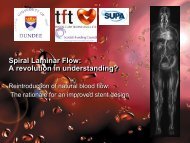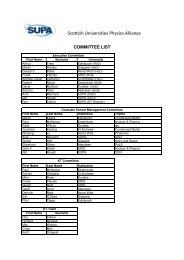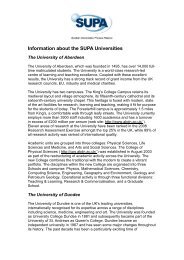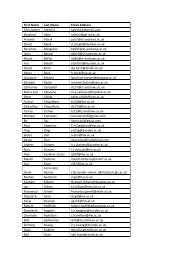Catalogue of Courses & Student Handbook - SUPA
Catalogue of Courses & Student Handbook - SUPA
Catalogue of Courses & Student Handbook - SUPA
You also want an ePaper? Increase the reach of your titles
YUMPU automatically turns print PDFs into web optimized ePapers that Google loves.
Physics and Life Sciences<br />
Introducing Biology to Physicists (<strong>SUPA</strong>IBP)<br />
Lecturer: Timothy Newman<br />
Institution: Dundee<br />
Hours Equivalent Credit: 20<br />
Assessment: Attendance, quizzes and short research project<br />
Course Description<br />
An overview <strong>of</strong> fundamental areas <strong>of</strong> biology for students with little<br />
biology background, emphasizing evolution, connections between<br />
length and time scales in biology, and the potential role <strong>of</strong> physics to<br />
inform biology at all <strong>of</strong> these different scales. Introduction: what is life?,<br />
Darwin’s theory <strong>of</strong> evolution, Mendelian genetics, tree <strong>of</strong> life, basics<br />
<strong>of</strong> prokaryotic cells, basics <strong>of</strong> eukaryotic cells. Biochemistry and<br />
molecular biology: structure and functions <strong>of</strong> proteins, structure <strong>of</strong><br />
DNA, DNA replication, transcription, translation, protein folding.<br />
Cell biology: membrane structure, membrane transport, metabolism<br />
and mitochondria, cytoskeleton, cell cycle. Multicellular organisms:<br />
germ cells, fertilisation, development. Populations: introduction to<br />
ecology, population genetics and evolution.<br />
The Theme <strong>of</strong> Physics and Life Sciences (PaLS) covers a large breadth<br />
<strong>of</strong> both physical and life sciences. As students come from a wide<br />
range <strong>of</strong> backgrounds and experiences, and are pursuing diverse<br />
PhD projects, the exact courses to be taken should be discussed with<br />
the student’s individual supervisor. <strong>Student</strong>s are also invited to select<br />
relevant courses from any <strong>of</strong> the themes and or to take appropriate and<br />
relevant non-<strong>SUPA</strong> courses within their home institution, but it is essential<br />
that the appropriate assessment (in the form <strong>of</strong> examination, written<br />
assignment or oral assignment) be discussed and agreed with the<br />
PaLS Theme Leader (Kishan Dholakia) in advance.<br />
Semester 1<br />
Biophotonics (<strong>SUPA</strong>BIP)<br />
Lecturer: Kishan Dholakia and Carlos Penedo-Esteiro<br />
Institution: St Andrews<br />
Hours Equivalent Credit: 33<br />
Assessment: Attendance, news and views article.<br />
This is a final year undergraduate course organised by University<br />
<strong>of</strong> St Andrews.<br />
Course Description<br />
The module will expose students to the exciting opportunities <strong>of</strong>fered<br />
by applying photonics methods and technology to biomedical sensing<br />
and detection. A rudimentary biological background will be provided<br />
where needed. Topics include fluorescence microscopy and assays<br />
including time-resolved applications, super-resolution imaging, optical<br />
tweezers for cell sorting and DNA manipulation, single molecule studies,<br />
photodynamic therapy, lab-on-a-chip concepts and bio-MEMS. Two<br />
thirds <strong>of</strong> the module will be taught as lectures, including guest lectures<br />
by specialists, with the remaining third consisting <strong>of</strong> problem-solving<br />
exercises, such as writing a specific news piece on a research paper,<br />
assessed tutorial sheets and a presentation. A visit to a biomedical<br />
research laboratory at St Andrews using various photonics methods<br />
will also be arranged.<br />
Collective Dynamics in Biophysical Systems (<strong>SUPA</strong>CDB)<br />
Lecturer: Antonio Politi and Francesco Ginelli<br />
Institution: Aberdeen<br />
Hours Equivalent Credit: 12<br />
Assessment: Oral Presentation<br />
Course Description<br />
The spontaneous emergence <strong>of</strong> collective behaviour is a universal<br />
property <strong>of</strong> biological systems that requires a proper theoretical and<br />
modelling framework to be fully understood. Our approach aims<br />
at showing that minimal models may capture many properties <strong>of</strong><br />
collective biological phenomena. Minimal model are based on the<br />
essential features <strong>of</strong> the system at hand, such as conservation laws<br />
and symmetries, and allow for a deeper understanding <strong>of</strong> the universal<br />
mechanisms lying behind many biological problems. We plan to<br />
introduce the basic concepts and tools – both analytical and numerical --<br />
<strong>of</strong> this approach by analysing two different classes <strong>of</strong> systems exhibiting<br />
non-trivial collective dynamics, both at the forefront <strong>of</strong> current research:<br />
Neural networks – Brain can be described as a network <strong>of</strong> mathematical<br />
models <strong>of</strong> single neurons, suitably coupled through various kinds <strong>of</strong><br />
synaptic connections. Various issues must be considered: single neuron<br />
dynamics (above/below threshold, number <strong>of</strong> local variables); synaptic<br />
connections (excitatory vs. inhibitory, synaptic own dynamics); network<br />
structures (random, scale free, sparse coupling, etc.). The various<br />
classes <strong>of</strong> collective dynamics are discussed.<br />
(ii) Active matter -- Active matter is composed <strong>of</strong> particles able to self<br />
propel themselves in a systematic way by extracting and dissipating<br />
energy from their surroundings. Systems <strong>of</strong> interacting active particles<br />
describe the collective motion observed in systems as diverse as<br />
animal groups (bird flocks, fish school, etc.), bacteria, molecular<br />
motors, as well as driven granular matter.<br />
26







